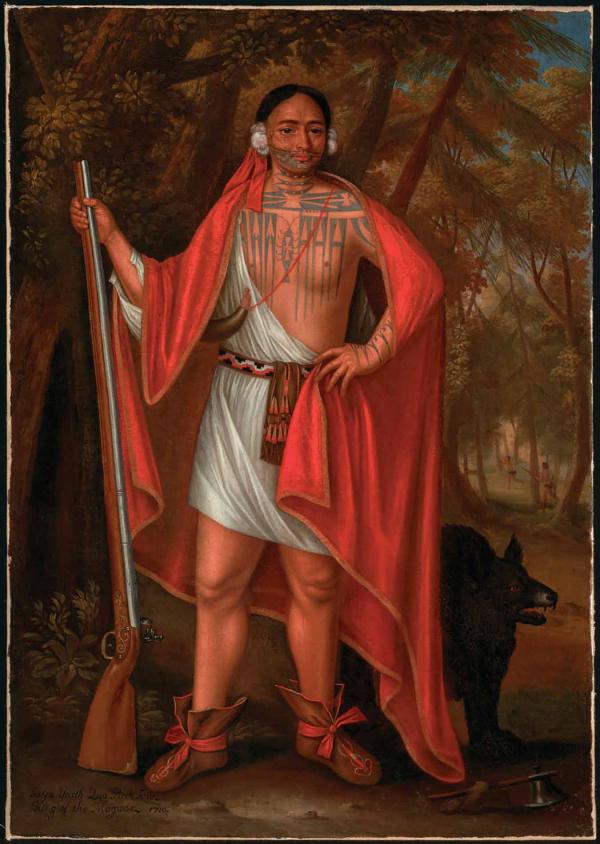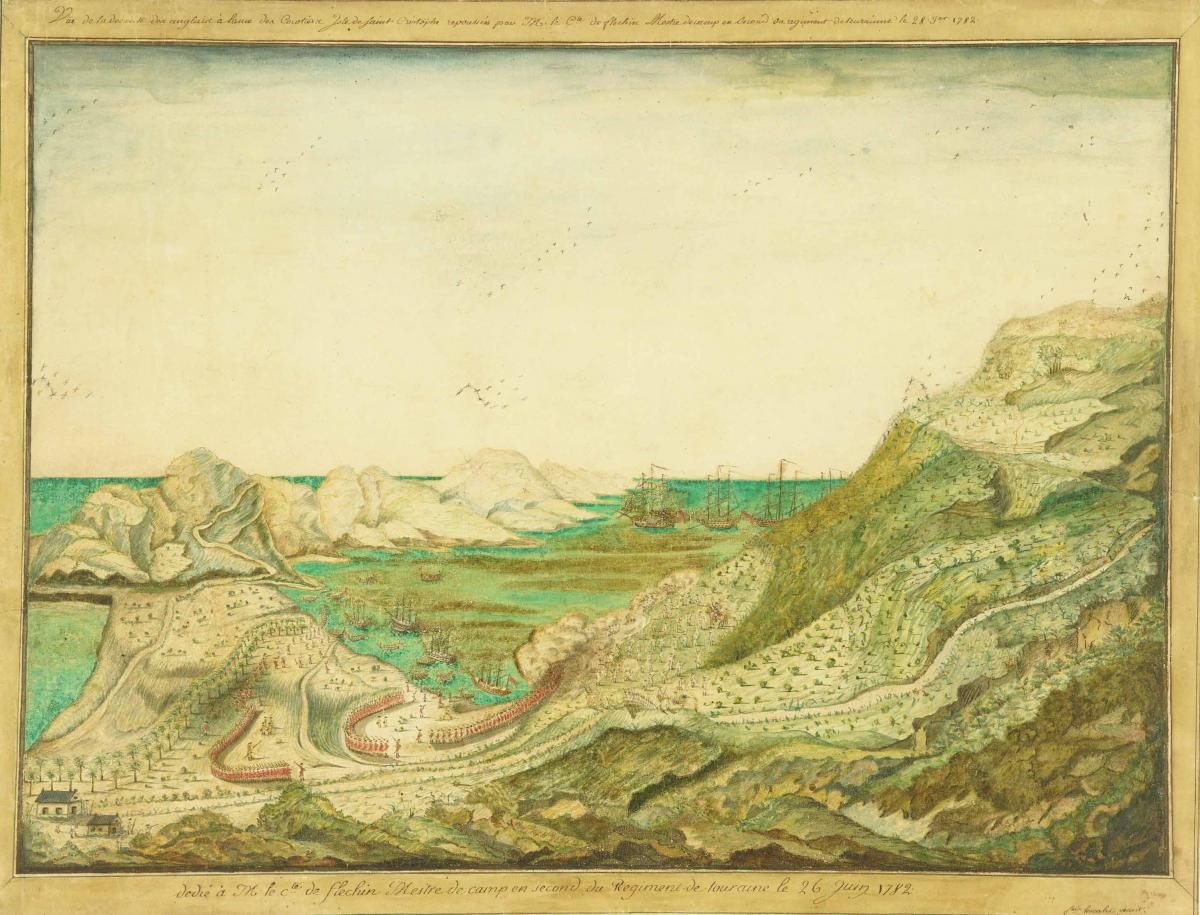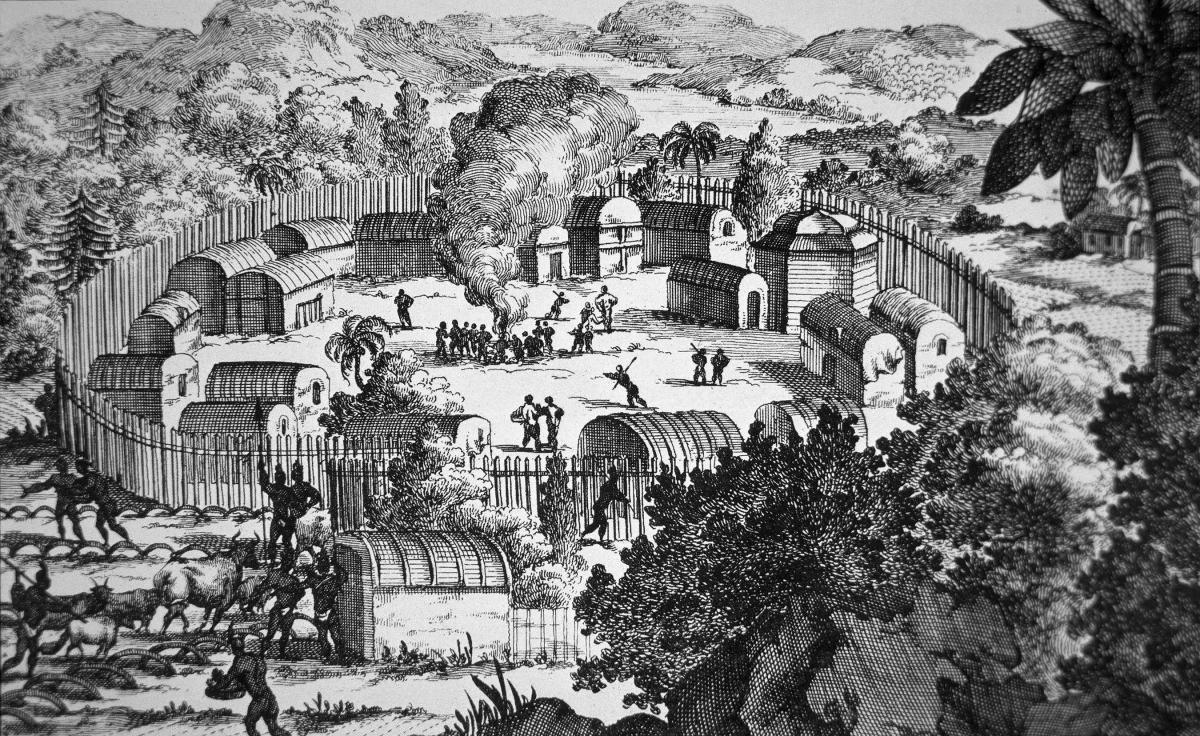American history courses usually begin with the peopling of the Americas, then move on to European colonization and the crisis of the British colonies. Tethered to the East Coast, historical attention turns west again as the United States expands its territorial claims in the nineteenth century. But a more expansive view of early America—what I and other scholars have taken to calling “vast early America”—would help us better understand the colonial and early national periods as well as the full sweep of American history.
To appreciate vast early America, let’s pick a year in the mid eighteenth century and an event that’s become more familiar thanks to the musical Hamilton. In 1757, Alexander Hamilton was born on the Caribbean Leeward Island of Nevis, where he would get his start as a clerk in a trading company. Just 36 square miles in area, tiny Nevis had become an engine of extraordinary wealth for the British Empire through sugar production and enslaved labor.
Also in 1757, Franciscan priests, in alliance with Apaches, established the Mission Santa Cruz de San Sabá in central Texas; within months, Comanches and their allies attacked and destroyed it.
In 1757, a hand-drawn map of the missions in Baja California was published in Madrid, illustrating the ongoing importance of the Pacific Coast to Spanish ambitions and suggesting the impact of missions on its native population.
By 1757, the Quapaws had long and deftly controlled territory in the Arkansas River Valley.
In 1757, the commander of French forces in North America ordered an attack on the British Fort William Henry at Lake George, between British-claimed New York and French-claimed Canada.
In 1757, John Saunders ran from slavery in Prince William County in northern Virginia; only 22 years old, he had a pronounced stoop, probably owing to the iron collar fixed around his neck.
From Nevis to Texas, to California, to Arkansas, to New York, to Virginia, with a stunning diversity of people and circumstances, this is vast early America. Readers may know one or more of these histories, but how these and innumerable other moments from across the extensive early American geography and chronology connect and fit into a collective narrative has been less certain. In traditional tellings, only Hamilton had a secure place in that story, and mostly from his later years, alongside George Washington as his aide de camp and Treasury secretary, as an author of The Federalist Papers, and, finally, as a tragic duelist.
Of all those 1757 moments, the least precise concerns the history of the Quapaws. The Quapaws’ durable political and social traditions made them adept at managing alliances, conflict, and trade with other native groups, and with Europeans, especially the French. Yet the gaps in exact dating remind us that days, seasons, and years of crucial historical developments among the Quapaws usually took place out of sight of European-style record-keeping. Still, the Quapaws—along with Apaches, Comanches, Spanish Franciscans, French soldiers, European officials, and enslaved Africans—helped make up early America.
According to research by Claudio Saunt, by the middle of the eighteenth century, after three centuries of traumatic demographic change and mere decades before the American Revolution, roughly 50 percent of the population within the borders of modern-day United States was Native American. Another 40 percent was European. Ten percent was African, almost all enslaved. The native population was distributed all across the continent, while Europeans and Africans were concentrated on the East Coast.
New American histories are offering an expansive view of the coming together of these dynamic, multilingual, globally connected, and often violent societies. The aim is to produce a deeper understanding of the daily lives of those who found and made meaning within these societies and of the powerful connections among them. Expanding the geography of early America lets us see a fuller North American story that incorporates an Atlantic and, especially, Caribbean, context. Expanding the conceptual framework of what constitutes a pre- and early history of the American nation, and analyzing new archival materials and methods, we can begin to appreciate a vital, vast early America that remains foundational but is also more particular and more complex.
Over the past two decades, scholars have developed and explored what look to be durable new frameworks for thinking about the broader geography of early America. The titan among these is the Atlantic World, which refers to those places that were navigable via the Atlantic in the early modern period. The Atlantic World directly connected Britain, the west coasts of Europe and Africa, the east coasts of North and South America, and the Caribbean. Created by trade, migration, and their violent iterations (the Atlantic slave trade, for example), such networks touched the lives of women, men, and children not only in North America and Europe, but also farther abroad, around Africa, to the Indian Ocean and, through routes crossing the Mediterranean and South America, to the Pacific.
A simple Google Scholar search for “Atlantic World” suggests how quickly this framework took off, appearing in article titles more than three times as often in the 1990s as the 1980s, and more than five times as often in the 2000s as the previous decade. There is now a robust, thriving scholarly literature on Atlantic history, and there are textbooks and undergraduate and graduate courses on the subject. That said, it should be kept in mind that, as historian Ian Steele remarked, “no one ever lived, prayed, or died for the Atlantic World.” Still, the Atlantic World is more than an academically useful construct.
Nations need histories, but national histories reflect artificial and retroactive borders of all kinds—economic, governmental, and social. A great strength of Atlantic history has been that it shows how often people and things moved across such boundaries. Historian Eliga Gould has described the European empires of the Atlantic World as “entangled,” in that their economies and polities—their histories—were regularly crossed and re-crossed by ordinary people.
Gould recounts a moment in 1741 on New Providence Island in the Bahamas when a British colonial official was asked to determine the status of Francisco Menéndez, a Spanish officer at St. Augustine, who was taken prisoner and, because of his “complexion and features,” said to be a slave and thus a legitimate part of a ship’s cargo. The quartermaster of the Boston-based sloop Revenge wanted to sell Menéndez, and argued that the man’s race should determine his fate under British law. The judge agreed. Yet the judge and the quartermaster both understood that although the Bahamas were a British colony, the case would need to accommodate differences in Spanish law, which was not racialized in the same way, and the desire of the Spanish government to have their military men returned. Local considerations eventually won out. By the late 1750s, Menéndez was back at St. Augustine, showing just how porous the boundaries of empires were for innumerable cases of trade, war, and exchange.
Goods, money, and people passed through extraordinary systems of exchange; disease, pests, and war also flowed in the wake of Atlantic imperial and commercial enterprise. Sugar, tobacco, and rice, grown in the Americas and the Caribbean, circulated north and south, but mostly east, along with goods hunted and mined or otherwise extracted. Goods moved from east to west, too, but mostly it was people moving in that direction. On a British estate paid for with the profits of a Jamaica plantation, tea from one part of the empire could be served with sugar from another. Africans were enslaved and transported, and they died by the millions to work those plantations and grow that sugar.
The most consequential Atlantic history is the history of the Atlantic slave trade. A key contributor to analyzing the trade itself is the Trans-Atlantic Slave Trade Database, a project first developed in the 1990s by historian David Eltis and a team at Emory University. The database now includes information, from the early sixteenth to the mid nineteenth centuries, on almost 36,000 voyages which forcibly transported more than twelve million enslaved people. Millions more enslaved people were taken to South America and the Caribbean than to North America, though, by the census of 1800, almost 20 percent of people living within what was then the territory of the United States were enslaved. The latest additions to the database, from historian Gregory O’Malley and colleagues, will track the intra-American slave trade.
Just as the Atlantic reached into the continent, early America stretched into the Atlantic. The early eighteenth century saw “Four Indian Kings,” three Mohawk and one Mahican, visit London and a delegation from the Illinois, Missouri, Osage, and Oto nations visit Paris. The influence of Native Americans on every aspect of the Atlantic World was sufficiently pervasive for one scholar to dub this phenomenon “the Red Atlantic.” The connected histories of Atlantic slavery and the deep interior of North America are made more plain by the increasingly detailed scholarship on Native American slavery, showing both how extensive the practice of selling Native Americans into slavery (even into Caribbean markets) became, but also how native slavery in the interior was influenced by the Atlantic slave trade.
The market for slaves in New France (the region stretching from Quebec to Louisiana), historian Brett Rushforth has shown, was fed by transforming native practices of war captivity. Rather than the traditional practice of taking captives to incorporate into their communities, captives were sold into a type of slavery rather like that of the Atlantic slave trade. Rushforth reveals the story of a native woman taken captive in present-day Iowa, traded through different native groups to the French, to Montreal as a domestic slave, then to Quebec, and then to a sugar plantation in Martinique. Through different cultures and different slaveries, she moved across a traumatic and dramatically different North American and Atlantic context.
This new research on slavery, says Tiya Miles, compels you to “rip your mental map in half and turn it upside down.” Despite extensive scholarship to the contrary, it is still frequently assumed that slavery in the U.S. was exclusively tethered to the South. And because the Northwest Ordinance ostensibly banned slavery, it was long presumed there was no slavery in places like Michigan. But, as Rushforth, Miles, and other scholars have shown, although there were many more people enslaved in the plantation economies of the South, slavery was just as deeply embedded in the culture and economies of places like the Upper Midwest and New England.
Just as Atlantic history helps us reframe early American contexts, borderlands history emphasizes the American Southwest and the relationship of the Spanish empire and Mexico with Native American lands, including territories claimed by other European empires and, later, the United States. At its peak in the mid eighteenth century, the immense Spanish empire in North America stretched from Central America through Mexico to California north of San Francisco, and east to the Mississippi River, plus Florida. In such borderlands, scholars contend, the authority of no political entity was paramount. Though European territorial claims in North America were impressive, they were mostly aspirational.
The political entities vying for authority and control over continental regions were more likely to be native than European. Native Americans, who had long responded to other native groups with trade or hostility, applied a similar range of reactions to European individuals, groups, and imperial designs. Historian Juliana Barr shows that the Caddos in the Texas borderlands, for example, expected newcomers to conform to native rules of diplomacy and trade. And Ned Blackhawk has shown how, for the Shoshones, Utes, and Comanches of the Great Basin, the cycles of violence instigated by European colonialism gave rise to increased violence from and among natives. A rich literature on what Kathleen DuVal termed “Native Ground” offers a multidirectional view from the coasts and the interior of the continent toward European arrivals, rather than from an English imperial (and then American national) east-to-west perspective. In short, a dense and rich historical literature illustrates Native American early America.
As all of these Atlantic and continental histories demonstrate, early America was geographically expansive and interconnected. There is no understanding early Virginia without also understanding early New Mexico, and vice versa. People in these places did not always understand their worlds as connected, and those connections were sometimes elastic and attenuated. But people did sometimes understand such connections because they were real enough to affect daily life.
This vast and inclusive early America does not appropriate distinctive histories and fields of scholarship such as the history of Mexico, of Latin America, of the Caribbean, or of Native American and Indigenous Studies. Rather, it sees them as essentially connected. But is Vast Early America too vast? Can we put all of these histories, including some that can only be gestured at here, of an Anglo-American legal and governmental tradition, a geographically expansive Atlantic history of multi-imperial commerce, the history of slavery, and of the enslaved, the complex histories of Native Americans across North America, within the frame of early America? Actually, we already have. These are not only deeply interrelated histories. They are mutual histories. The cumulative scholarship of the past two decades has shown us how significantly we understand each area and discipline better in relation to the others, and that we understand early America best when it is most inclusive.
For a long time, early American history had an identity crisis that passed as a nomenclature challenge. What is “early?” By modifying “America,” does that mean that “early America” is by definition—and ahistorically—a field about what would come next? Which “America?” There are two American continents, after all. And who were “Americans?” Native Americans are the earliest Americans; millions of enslaved Africans were unwilling migrants; European immigrants began arriving in North America first with the Spanish efforts at colonizing Mesoamerica. Sometimes “Colonial America,” beginning with the arrival of Europeans in North America in the 1400s and implicitly emphasizing the British, not Spanish, colonies, was synonymous with “Early America.” That connection to colonialism presumed the primacy, and usually the perspective, of Europeans (the “New World”) rather than Native Americans. Often “Early America” combined this version of the colonial period with the American Revolution and the Early Republic as a sinuous pre- and then early history of the United States.
The connection to the early United States has long made early American history both terribly compelling and particularly vexed. It answered the question of whether history is about people, place, or polity, with a resounding affirmative only for the last. It cemented the significance of British colonists on the eastern seaboard, some of whom rose up against the British and persisted to the point of revolution to establish the United States, while minimizing the context of the Caribbean and of the full North American continent. The military and political history of colonial British America and the American Revolution is key to understanding the development of the United States in its early years and beyond, of course. But, then, does that mean American geography only turns westward, over the Appalachian Mountains and on toward the Pacific once the United States officially claimed more territory?
As a shorthand for this conundrum, does California have an early American past?
Since the 1890s, academic historians have stressed the importance of setting early America in the context of its own time, rather than only as background to the sweeping national history of the nineteenth and twentieth centuries. For far longer, native scholars have sounded the same alarm, insisting, as Pequot writer William Apess observed in A Son of the Forest in 1829, that European perspectives had been driving historical narratives: “Ever since the discovery of America by the celebrated navigator, Columbus, the ‘civilized’ or enlightened natives of the old world regarded its inhabitants as an extended race of ‘savages!’” And the accounts of African-Atlantic writers as early as the eighteenth century sounded their own call for an accounting of the histories of slavery and freedom. Collectively, these voices have been calling attention to the importance of an early America that, though discontinuous in many ways, was formative for the American nation and those that lived then, and live now, within its borders.
The newly expansive geographies of early America have developed alongside fresh perspectives on historical source material. To paraphrase the great Haitian anthropologist Michel-Rolph Trouillout, history is not sitting in a kitchen cabinet, just waiting to be opened and seen. History is what we understand about the past; we understand it differently over time, and how that understanding evolves has long depended on the types of sources we study. The traditional sources for early American history were largely housed in East Coast historical societies and libraries, whose founders in the early nineteenth century institutionalized the perspectives and priorities of that era. The manuscripts of prominent, almost exclusively, elite white men and their families as well as organizational records of government and other institutions (churches and universities) formed an essential corpus for the historical narrative. These collections, from which historians have worked for many, many decades, generally prized printed texts over manuscripts, and text over objects and images, and European perspectives over Native American perspectives and oral traditions.
Understanding these collections as a reflection of historical processes and priorities has helped bring new histories to light. Occasionally, an exciting new collection of sources appears, but often it is the case that scholars learn to evaluate known materials differently, using new methods and approaches or simply asking new questions of the same sources. The records of the slave trade, for example, on which the enormously important database is built, are principally the logbooks and other financial accounts written by ship captains and their investors. These materials have allowed scholars to see the size and shape of the slave trade, but not the perspective of enslaved people, or the character of slavery itself. Historian Stephanie Smallwood argued for the importance of reading the correspondence of slave-trading officials and their agents to show the “human side” of the trade through the ways that the traders acted in commodifying the men and women they took and the ways that those people resisted. Other historical records of slavery include runaway advertisements in colonial newspapers. Written by those who enslaved men, women, and children, these advertisements helped spread a suspicion that all black people found outside of the immediate supervision of whites were runaways. Historians, however, can also use these ads to understand the perspective of enslaved people by examining the language depicting them, the material goods they carried, and the circumstances of their escapes.
Institutions are also reevaluating their collection and cataloging practices. The way that historical materials have long been described in library catalogs reflected the same priorities and some of the same biases as dominant historical narratives. At the American Philosophical Society’s Center for Native American and Indigenous Research, a new subject guide to their extensive collections includes more detailed information about the location and native origins of specific materials. It also includes recognition of the indigenous authors and experts who created or helped curate these materials.
Even the most conventional of political subjects and materials are being exposed to newly critical examinations and to new technologies. Legal historian Mary Sarah Bilder recently revealed, through close textual analysis and forensic techniques, how James Madison edited his own notes on the Constitutional Convention. Casting himself and challenging positions around slavery and other subjects in a better light by revising or replacing pages of his notes, Madison was retrospectively shaping these materials that scholars have long accepted as an authoritative account of what happened during this most critical moment in the early United States. A project to digitize all of the papers of the Georgian monarchs, held at Windsor Castle, is a collaborative effort between the Royal Archives and King’s College London, joined by primary U.S. partners, the College of William & Mary and the Omohundro Institute. These materials—correspondence, diaries, account books, household, and other records for the royal residences—are being used to explore some of the most important questions of the eighteenth century: about empire and revolution, medicine and science, race and slavery. As we look toward the 250th anniversary of the Declaration of Independence, less than a decade away, we find that even this archive, at the very heart of Anglo imperial power, will help us illuminate our vast early America.
Some recent critiques of early-American scholarship note that increased attention to diverse people (women, enslaved African Americans, Native Americans) and places (California, the Caribbean, West Africa, Atlantic port cities) takes us outside the framework that marches us from Colonial (British) America to the Revolution to the early United States. According to this complaint, the broader view of early America renders us less able to speak to the nature and origins of our nation. The argument for the traditional version of early America is that the basic laws and governance of the United States are rooted in an Anglo-American tradition, which is occluded by attention to the longer histories of places and people less closely connected to that tradition or that only “became” part of the American polity later on.
I could not disagree more. I would even go so far as to say that an American national history that does not see the depth and breadth of Native America across its historical landscape, that does not see slavery lying at the bedrock of the American experience, that overlooks the centuries-long significance of Mexican-American heritage cannot appreciate the great democratic ambitions the United States has articulated, defended, and pursued for almost two and a half centuries.
Go back to 1757. As the musical Hamilton asks, How did “a bastard, orphan, son of a whore and a Scotsman” from a “forgotten spot in the Caribbean, grow up to be a hero and a scholar?”
Hamilton’s story is an early American story about the economy of Caribbean sugar and slavery and about the nexus of indigenous, African, English, French, Spanish, and other people across the huge expanse of early America from which he emerged. Yes, he was well read in political philos-ophy, and he went on to wield his skills to remarkable effect. And a well-developed, and still growing, political history of Anglo America will always be an essential part of American history. But it is only a part.
Alexander Hamilton, George Washington, and other political leaders of the early, eastern United States will continue to stride through the pages of our histories, but they will occupy that space as slaveholders as well as political leaders, and they will share that space with other people and places that will help us understand these founders better. A capacious approach to early America shows us a past that was infinitely complex, dynamic, globally connected, and violent. And it also still shows us—better shows us—the origins of an ambitious, powerful, and democratic nation. In short, we need an early American history, but one that fully grasps the depth, breadth, and complexity—the vastness—of early America. That is both good history and good civics.








